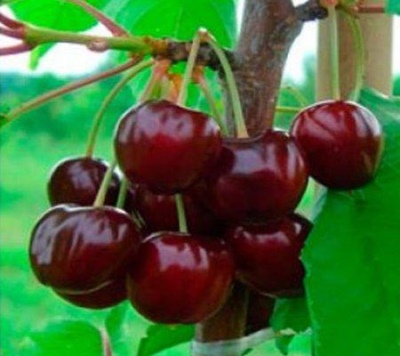
- Pruning: vertical shoots and crown tops
- Fruit shape: rounded, slightly flattened
- Peduncle: medium length and thickness
- Authors: L.I. Taranenko (Donetsk Experimental Station)
- Appeared when crossing: Drogana yellow x Valery Chkalov
- Year of approval: 1995
- Growth type: vigorous
- Appointment: universal
- Yield: good
- Crown: round, medium density
Among the many cherry varieties, there is a list of the varieties most beloved by gardeners and farmers. Among such cherries is Donetsk coal, which has absorbed all the most positive characteristics.
Breeding history
Donetsk coal is a bright representative of Ukrainian selection, created at the Artyomovsk experimental station (Donetsk region) in 1956. The author of the late cherry variety is the well-known breeder Lilia Taranenko. The parental forms of sweet cherries are Drogana yellow and Valery Chkalov. The variety is productively cultivated in the North Caucasus, in the Crimea and in the Krasnodar Territory.
Description of the variety
The Ukrainian cherry is a medium-sized tree with a neat rounded crown, which is moderately thickened with emerald green leaves. In a favorable environment, a cherry tree grows up to 3-3.5 meters in height. At the initial stage of life, the tree grows rapidly, so by 4-5 years the crown is completely formed.
Flowering is observed from early April to early May, depending on the region. Flowering lasts about 3 weeks. At this time, the spherical crown is densely covered with single or triple pinkish-cream flowers, which emit an incredibly sweet aroma. Due to its beauty during flowering, the tree is rightfully considered decorative.
Fruit characteristics
Donetsk coal is a large-fruited variety. Berries grow on the tree weighing 8-9 grams. The shape of the cherries is round, with flattened sides, which are a bit like hearts. Ripe berries are evenly covered with a dark red color with a smooth and shiny surface. The peel of the fruit is of medium density, good protection against cracking. However, 20% of cherries can crack during ripening only if they are excessively damp and rainy. The abdominal suture is weak.
Cherry keeps on a thickened stalk, pulling dry. That is why the berries can be transported over long distances, as well as stored for a long time in a cool place. The purpose of the variety is universal - cherries are eaten fresh, canned, processed into jams, juices, drinks, they make preparations, and are widely used in cooking.
Taste qualities
Donetsk coal - has excellent taste and marketability. The pink-red flesh is characterized by a fleshy, tender, moderately firm and slightly cartilaginous structure, complemented by good juiciness. The taste of the fruit is dominated by sweetness, which is perfectly combined with a piquant sourness in the aftertaste. Cherry juice is thick, rich, not darkening even after processing. The rounded stone inside the berry is easily separated from the pulp.
Ripening and fruiting
Ukrainian cherries represent the category of late-ripening varieties. The first harvest can be obtained in the 4th-5th year after planting a one-year-old seedling. Sweet cherries do not ripen at the same time, so the harvest period is delayed by 10-14 days and takes place in several stages. The peak of active ripening of berries begins in mid-July. Fruiting of the variety is annual.

Yield
The yield of the variety is high, growing over the years. With proper care and favorable weather conditions, on which the yield indicator directly depends, an average of 45-50 kg of berries can be obtained from one tree. The maximum yield indicators are as follows - from 80 to 100 kg per tree. As a rule, the most bountiful harvests are given by 10-12 year old trees.
Self-fertility and the need for pollinators
The variety is self-fertile, requiring donor trees. For cross-pollination, varieties with the same flowering time are suitable. The following types of cherries are considered productive - Valery Chkalov, Aelita, Donchanka, Yaroslavna, Drogana yellow, Annushka, Valeria, Donetsk beauty. Usually 2-3 pollinating trees are planted on the site.
Growing and care
A cherry tree is planted in spring or autumn. To do this, choose a flat area where there is a lot of sun and light, but there is protection from wind and draft. It is best to plant a two-year-old seedling on a small hill, where there is no stagnation of moisture, harmful to the root system.
Sweet cherries are undemanding to care for, however, the main procedures need to be carried out: watering, fertilizing, weeding and plowing the soil, forming a crown, removing dry branches, thinning, preventing diseases and preparing for winter.




Disease and pest resistance
The immune system of the stone fruit culture is high. The tree perfectly resists fungi, does not undergo coccomycosis and moniliosis. In addition, cherries practically do not attract pests.

Requirements for soil and climatic conditions
Sweet cherry loves a lot of light, warmth and sun. The culture is characterized by moderate frost resistance, as well as resistance to prolonged drought. The tree grows comfortably in loose, nutritious, moisture and breathable soils.
































































